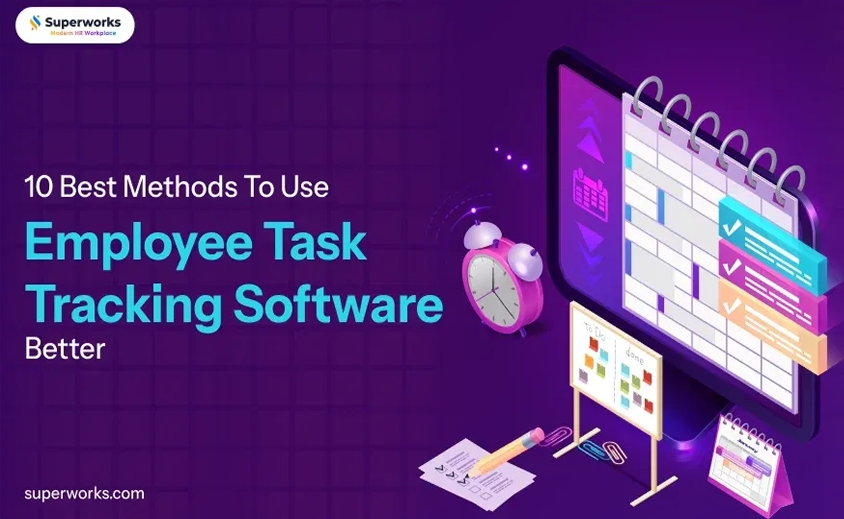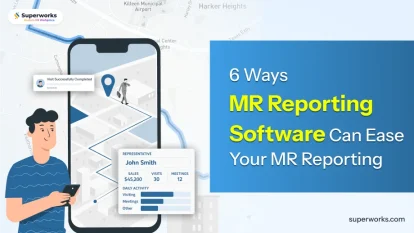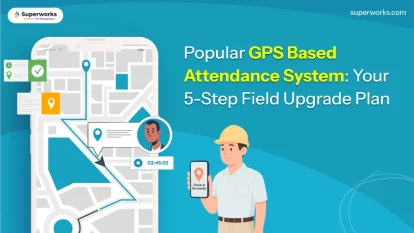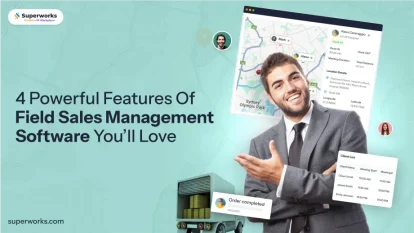
How do I track my employees’ daily work? or
How to maintain an activity log for field tracking? or
What’s the best way to use employee task tracking software?
In today’s time, such questions are quite frequent for the field managers and the operational head, for whom they need answers. However, in the quest for finding answers to these questions, not many get succeed. So, let us help you with that.
For efficient employee task tracking, what you should do is set clear goals, choose the right tool, and make sure your team actually uses it the way it’s meant to be used. But there’s a lot more to it than just logging tasks and watching progress bars.
This blog will give you 10 practical methods to make better use of any employee task tracking software. We’ll go over how to train your team, manage tasks in the field, and make use of features like real-time tracking, task updates, and integrations that matter.
By the end of this blog, you’ll know how to:
- Keep your team members on the same page, even across different locations
- Reduce manual work and get better visibility into employee productivity
- Handle multiple projects without losing track of task progress
- Improve team collaboration using the tools you already have
If your day involves assigning tasks, checking project milestones, or making sure field teams hit project deadlines, this guide is built for you.
What is Employee Task Tracking Software?
Employee task tracking software helps you assign, manage, and track tasks across a team, whether they’re in the office or out in the field.
Think of it as a central hub where you can:
- Create projects & tasks with due dates, task details, and task dependencies
- Monitor project progress and task updates in real-time
- Use task templates to speed up recurring tasks
- Track time spent on each task using built-in time tracking tools
This kind of task management system is especially useful for field managers who oversee multiple projects or coordinate teams in different locations. It gives a comprehensive overview of what’s going on without needing to micromanage.
Plus, the best task management software options offer a user-friendly interface, mobile access, and collaboration tools like built-in chat features and file sharing. These features help reduce the learning curve and improve team collaboration instantly.
So, are you ready for the first method? Then, let’s begin,
Keep every field project on time - and track them seamlessly.
Start today with Super Field Force & feel the difference.
Method 1: Set Clear Objectives for Task Tracking
Without clear goals, tracking tasks turns into busywork.
Start by deciding what you want to achieve—like better time tracking, faster project progress, or fewer missed deadlines. This helps you assign tasks with purpose and track progress that actually matters.
Use your task management tool to:
- Create tasks that support your bigger goals
- Set deadlines and track tasks tied to project milestones
- Focus team members on what moves the project forward
Clear objectives also make it easier to review team performance and improve your task assignment strategy.
Method 2: Choose the Right Software for Your Team
Pick a staff time tracking software that fits how your team actually works in helping tracking employee tasks—not just what looks good in demos.
Field managers need a task management system that works on mobile, handles multiple projects, and supports real-time tracking. If the tool is too complex or lacks offline access, your team won’t use it, and you will probably to fail to get answers on “how to track employees daily activities?”
Henceforth, when choosing employee task tracking software, look for:
- User-friendly interface for easy task creation and updates
- Built-in time tracking to track time spent on-site or on the road
- Collaboration tools like chat, file sharing, and task comments
- Free task management software options if the budget is tight
The best task management software should help you manage tasks, organize tasks, and stay on top of project deadlines without needing a full day of training.
Also, check if it can scale for ongoing projects and if it fits with your current business processes. A good fit from the start saves time down the line.
Method 3: Train Employees Thoroughly
Even the best task management software won’t help if your team doesn’t know how to use it. And for your information, having more advanced features won’t solve your problems.
Henceforth, training is key—especially for field teams who rely on quick updates and mobile access. Walk them through how to create tasks, update task details, and track tasks from start to finish.
Focus on:
- How to assign tasks and set deadlines
- Where to find task updates and project progress
- Using task templates for recurring tasks
Keep the learning curve low. Use short training videos or simple checklists. And make sure team members know who to ask when they get stuck.
Once the basics are clear, your team will spend less time figuring things out and more time doing the work.
Method 4: Customize the Software to Fit Your Workflow
Don’t use default settings if they’re slowing down your team.
Most task management tools let you use key features and tweak dashboards, task views, and notifications. Use that to match your team’s habits and how your projects actually run.
Here’s what to adjust:
- Rename or reorder task stages to match your project timeline
- Set up task dependencies for complex projects
- Add custom fields for things like location, priority, or time spent
Customizing helps you organize tasks better and keep everyone on the same page. For field managers, it also means faster task assignment and fewer updates missed in the chaos.
Use these changes to make the tool work for you—not the other way around.
Method 5: Integrate with Existing Systems
Your employee task tracking software shouldn’t work in a silo.
Henceforth, you should connect it with the other tools you’re already using—like HR systems, calendars, or communication apps. Integrations help reduce manual work and speed up task updates.
For field managers, key integrations include:
- Project management software for better project planning
- Time tracking software to log hours without switching apps
- Collaboration tools to chat and share files in one place
This saves time, avoids double entry, and gives you a more complete picture of your team’s work across multiple projects.
Pick software that supports these integrations out of the box or offers easy ways to plug into what you already use.
Method 6: Monitor Key Performance Indicators (KPIs)
Tracking tasks is good—but tracking results is better.
Henceforth, what you should do is to set clear KPIs tied to your tasks. This might include task completion rates, time spent, or how well team members stick to project deadlines.
Here’s how KPIs help:
- Spot bottlenecks early in ongoing projects
- Measure employee productivity without micromanaging
- See which team tasks need more support
Use your task management tool to pull reports and view data in real-time. Most systems make it easy to create reports based on task progress, overdue tasks, or time tracking logs.
Pick a few key metrics that reflect your team’s work—and check them often.
Method 7: Encourage Employee Engagement
Task tracking works best when your team is actually on board.
Field teams won’t use the system just because it’s there. You’ve got to show them how it helps—like reducing repetitive tasks, keeping everyone aligned, and making it easier to complete tasks on time.
Here’s what helps:
- As a project manager, first explain the “why” behind task tracking, task prioritization, and more.
- Use task assignment to show trust, not control
- Highlight wins from productivity tracking
Also, make the system easy to use. A user-friendly interface, simple task creation, and fewer clicks to update task details go a long way.
The more your team buys in, the smoother your task management system will run.
Method 8: Regularly Review and Adjust Practices
Set it and forget it doesn’t work with task management, just like it doesn’t work for resource management.
Because the project needs change. Team structures shift. What worked three months ago might not work today. That’s why regular check-ins for each individual tasks are key.
Every few weeks, take a look at:
- Which tasks are always late or unclear
- Where team members get stuck
- What features of the task management tool are never used
Use these insights to adjust how you assign tasks, set priorities, or track progress. It’s also a good time to update task templates and remove clutter.
Small tweaks can make a big difference, especially for field managers dealing with fast-moving projects.
Method 9: Leverage Mobile Capabilities
Field teams need access on the go—desktop tools won’t cut it.
Choose task management software that works well on mobile. Your team should be able to assign tasks, check updates, and track progress from their phone or tablet.
Look for:
- Mobile access with offline support
- Quick task updates and task creation on-site
- Real-time tracking of task status
A mobile-friendly task management tool helps boost productivity, and keeps your team members connected, even if they’re in different locations or have spotty service. It also helps reduce delays from waiting to get back to a computer.
Henceforth, this is a must-have for managing team tasks in the field.
Method 10: Ensure Compliance and Data Security
You’re tracking a lot—make sure it’s protected.
Henceforth, to ensure real-time tracking, field managers often have to deal with sensitive data like location info, schedules, and employee performance. Your task management software needs strong data security features.
Make sure it includes:
- User permissions to control who sees what
- Secure access, even on mobile
- Regular backups and data encryption
Also, check that it meets your industry’s compliance rules. Whether it’s field force management software or a broader task tracking tool, data security isn’t optional.
A breach or mistake can cost more than time—it can break trust with your team.
Conclusion
So, now that you know the answers to “How to track employee daily work?”, with the best methods, let’s conclude the blog with a thought.
Getting task tracking right isn’t about using more tools—it’s about using the right methods with a system that matches how your team works in the field.
The steps we’ve covered here, in this blog are about—setting clear goals, choosing the right software, training your team, and keeping everything mobile-friendly—are all about one thing: making sure nothing slips through the cracks when your team is spread out across locations.
The reason behind the detailed explanation is that we know that, as the field managers, you already have enough on your plates. That’s why the tools you choose should simplify task assignment, reduce manual work, and give you real-time insight without constant check-ins.
So, if you’re managing ongoing projects, coordinating remote teams, or just need a clearer view of what’s getting done, it might be time to switch to a system built with field work in mind.
Some tools are just made for offices. While there are some amazing tools like Super Field Force of Superworks, which, according to experts, are the best field force management software for both field teams and field managers. So, do understand the difference, and for more info about the tool, like how it can help you design a fail-proof field management system, connect with our experts now!





